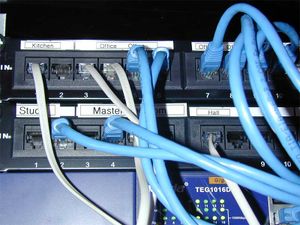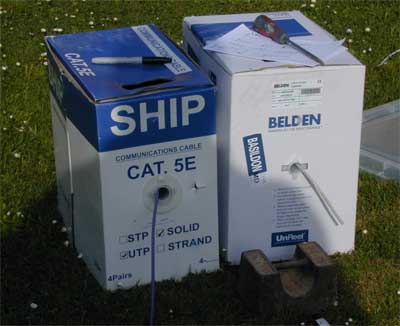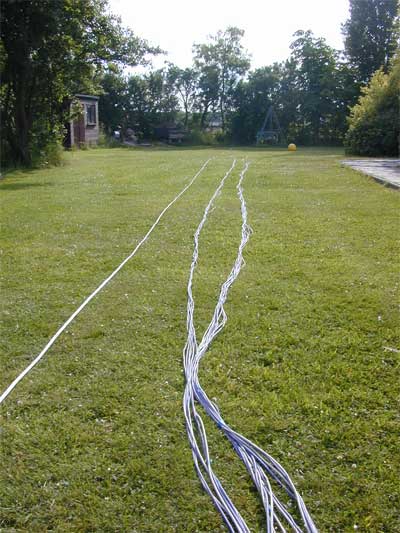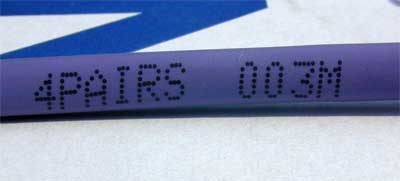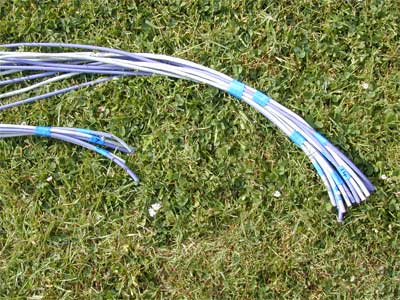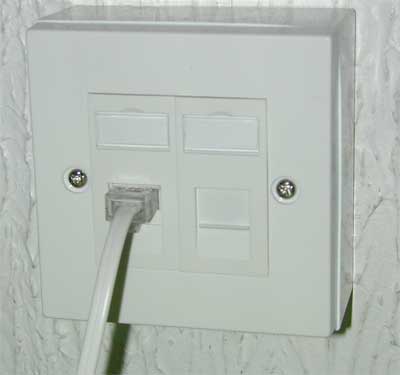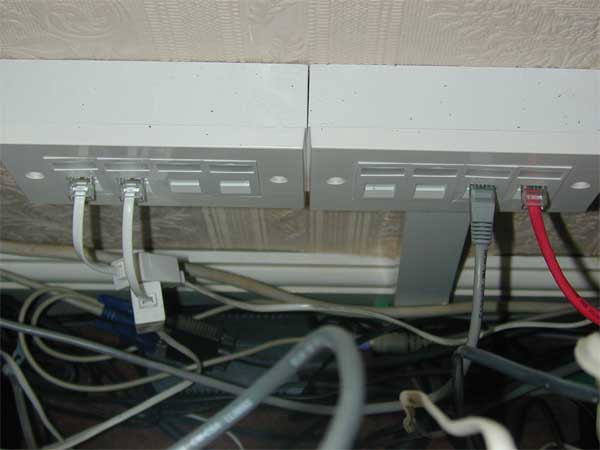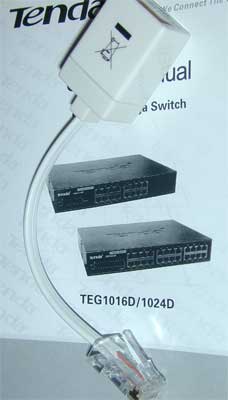Difference between revisions of "Structured wiring system"
(First draft for public consumption) |
|||
| Line 24: | Line 24: | ||
It is worth spending some time on your design, since the materials are cheap, but the disruption and time taken to get it all installed is better only endured once! | It is worth spending some time on your design, since the materials are cheap, but the disruption and time taken to get it all installed is better only endured once! | ||
| + | #Select a suitable location for your communications hub. Something like an under stairs cupboard is often ideal. You want location that is easy to wire to and from, and has (or can be given) power and light. | ||
| + | #Decide all the places in the house where you may want to install a phone, computer, or AV equipment like hard drive recorders, satellite boxes or TVs. | ||
| + | #For each location, allocate at least two cables (always run a minimum of a pair!). If you expect the location will have lots of equipment concentrated close to it, then allocate more cables. | ||
| + | #Count up how many cables you have and select patch panel(s) with enough ways to accommodate all your cables plus a few spare. | ||
| + | #Select suitable ethernet (and PABX if using one) switch with enough ports to accommodate all the equipment you plan to install. | ||
| + | #'''Carefully''' measure the distance from you hub position to each room socket and record these on a list. Allow enough spare cable to have an extra 1 - 1.5 meters at the hub end, and an extra meter at the wall socket ends. | ||
| + | #Add up all the lengths and decide how much cable to buy. To make installation easy it is better to always have a minimum of two reels of cable. | ||
| − | + | When deciding on cable runs try to avoid routes that run in close proximity to mains wiring or other possible sources of interference. | |
==Implementation== | ==Implementation== | ||
===Preparing Cables=== | ===Preparing Cables=== | ||
| − | === | + | In many cases it will be simpler to install the cables in "looms" i.e. bunches of pre-cut cables that are to follow a particular route. That way a large number of cables can be pulled in in one go. |
| + | |||
| + | Start by preparing a cutting list. Find some open space, and lay out a tape measure. Since you will be running cables in pairs it is much simpler to have a pair of cable reels to work from: | ||
| + | |||
| + | [[Image:PairCat5Boxes.jpg]] | ||
| + | |||
| + | (and it often helps to use different colours. That way it is clear which cable of a pair you are dealing with at any socket location. | ||
| + | |||
| + | Drag out a pair of cables to the length of your longest pair in the loom. Then tape them together at intervals of every metre or so, plus at each end. Finally use a permanent marker or some other system to label each end. The repeat for the next shortest pair and so on. Once you have a group of cables you can also tape them together to make the bunch more manageable. If you have the space and a long tape measure then this is quite easy to do: | ||
| + | |||
| + | [[image:LoomAssembly.jpg]] | ||
| + | |||
| + | If you don't have as much space and need to coil the cables soon after cutting, or you don't have a long enough tape measure, then use the length markers printer every metre on the side of the cable: | ||
| + | |||
| + | [[Image:CableLengthMarker.jpg]] | ||
| + | |||
| + | Once you have all the cables for a particular group assembled together and taped up, you can carfully coile them for storage until installation. | ||
| + | |||
| + | [[Image:LoomsDone.jpg]] | ||
| + | |||
| + | ===Cable Loom Installation=== | ||
| + | The next task is to install the cables in the house. Many of the techniques described in the [[Electrical Installation]] article can be used for guidance on doing this. | ||
| + | |||
| + | ===Sockets=== | ||
| + | The next stage is that of installing all the sockets and patch panels. Not a difficult task, but it can get repetitive! Sometimes it helps to get all the socket box mounting done first so that you can concentrate on the actual wiring all in one go. | ||
| + | |||
| + | Room terminals can be either small single accessory modular faceplacets: | ||
| + | |||
| + | [[Image:ModulaWallSocket.jpg]] | ||
| + | |||
| + | That take a pair of sockets side by side, or for rooms requiring more connections use wide multiway connections: | ||
| + | |||
| + | [[Image:MultiWallSockets.jpg]] | ||
| + | |||
| + | At the hub end it often helps to install a small comms cabinet to keep everything together and tidy: | ||
| + | |||
| + | Image:CommsCabinet.jpg | ||
| + | (the picture shows a 7U wall cabinet) | ||
| + | |||
| + | Cabinet sizes are specified in Units or simply "U". 1 unit is typically the smallest device that you would install in a cabinet. Each of the patch panels and the ethernet switch shown above are 1U high. | ||
| + | |||
| + | One would usually wire up cables to the patch panel following the sequence number you assigned to each cable during the design phase. | ||
| + | |||
| + | ===Wiring Up=== | ||
| + | Modern datacomms wiring is all designed to be assembled with the minimum of fuss using insulation displacement connector "punch down" terminations. The outer sheath is stripped from the cable and the inner wires are laid into the corresponding colour coded terminals of the socket. Finally a "Krone" type [http://www.solwise.co.uk/networking_sundries_krohn-tools.htm|punch down tool] will push the wire into the terminal. The better tools will also trim the wire to length in the same action. There is no need to strip the insulation from the individual wires since the socket terminals are designed to cut through it and make the connection. | ||
| + | |||
| + | If you are wiring a few it is well worth investing in a good quality tool since it will not only work better and faster, it will also usually have some nice extras like a small hook tool for pulling wires free when you accidentally punch them down to the wrong terminal! | ||
| + | |||
| + | A [http://cpc.farnell.com/ideal/45-165/utp-stp-cable-stripper/dp/TL03165|UTP cable stripper] is also very handy. These remove the outer insulation from this type of cable with no effort and no risk of damage to the inner cores. | ||
| + | |||
| + | When wiring, most sockets provide a place to allow a cable tie to be fixed - and thus hold the cable to the sockets. Fit this first. and then terminate the individual wires. Make sure you get the right wires in the right terminals. Its not enough that the end to end connections are ok, the actual wires used must be arranged in the right order such that the pairs are kept together for each function. Just to add a little complexity there are several standards for the wire arrangements. The most common ones being refereed to as [http://en.wikipedia.org/wiki/TIA/EIA-568-B EIA 568A, and 568B]. Which you actually use does not make much difference - but make sure to use the same at both ends of the cable otherwise things won't work correctly. Where possible use the same standard for the whole installation. | ||
| + | |||
| + | Each pair of wires in a CAT5 cable is twisted together. This is fundamental to the way the cable performs when carrying high speed data. It is good practice only untwist as much as necessary when terminating each pair. This helps maintain the noise immunity of the cable. | ||
| + | |||
| + | ===Labelling=== | ||
| + | When complete you can wither label the patch panel with the names of the locations of the remote sockets, or simply number each port with a unique number that is matched on the wall socket. This will allow you to tie up a particular wall socket with its matching patch socket. | ||
| + | |||
===Testing=== | ===Testing=== | ||
| + | The final stage is testing. For a small number of sockets, you can test with known working computers / phones etc. However to do the job easily a basic network cable tester is a much better way. These start from about £30 in most electronics supplies catalogues. The tester will identify any errors in your wiring, or any problems resulting from damage done to the cables during installation. Note that not all pairs of a cable are used in each application. Analogue Telephones only use one pair, and 10 - 100 Mbit ethernet only uses 2 pairs. So it may be possible to use a less than perfect cable for the application at hand anyway. | ||
==Use== | ==Use== | ||
| − | === | + | Using a structured wiring system is simplicity itself. |
| + | |||
| + | ===Data=== | ||
| + | Connect your ethernet device directly to the socket at the far end, and the ethernet switch to the patch panel via a short prtch lead. | ||
| + | |||
| + | ===Telecoms=== | ||
| + | Analogue telephone connections typically only use one pair of wires, for most of the journey. This avoids the normal problem that can occur with UK based phone wiring where there is need for a third unbalanced wire (the "bell" wire) to be routed around to every socket. This extra wire can pickup unwanted noise and hum in the process. | ||
| + | |||
| + | With a structured system this bell wire is only recreated at the point of use using a plug in device called a Line Adaptor Unit (LAU) [[Image:PhoneLAU.jpg|thumb|right|LAU for attaching phone to RJ45 socket]] | ||
| + | These adapt the RJ45 socket to take the normal BT style phone plug, and also include a ring capacitor to provide the missing bell wire. | ||
| + | |||
| + | ===Audio / Video=== | ||
| + | It is also possible to send audio and video signals down structured wiring. To do this you will need a pair of "Balun" devices to convert the signals to and from suitable formats for transmission. eBay can often be a source of low cost devices! | ||
| + | |||
| + | The alternative way of getting video down the wire is using a media player device. These typically connect to a TV and a central computer or file store and stream audio and video files from it to the TV. In practice these can be treated exactly as described for data connections above. | ||
| + | |||
| + | ===Splitting signals=== | ||
| + | Sometimes it is handy to be able to split a signal and direct it to more than one socket. Say for example when connecting a phone line to a number of locations without the use of a PABX. This can be done simply using some spare patch ways on your patch panel. Simply wire together three spare sockets. They can then be used to split one signal two ways. Note this is only usually of practical use for telecomms use rather than data. | ||
Revision as of 23:38, 24 July 2009
| ||
| If you are thinking of editing this page please be aware that the original author(s) of this page may be actively working on it at this moment, so changes you make may clash with theirs. (The Wiki software will warn you of conflicts if this happens.) Checking the page's history tab for frequent recent edits can warn you if changes by others are likely. |
A structured wiring system is a flexible and expandable way of installing telecommunications and computer networking capabilities into a home or office. Once the domain of commercial and office installations, there are now many good reasons for installing a system in the average home. This article describes the basics.
What can I do with it?
A structured cabling system will allow to to reliably interconnect computer and telephone equipment around your home. Hence you can:
- share file, folder, printers, and your internet connection between your various computers.
- Install telephones where you need them
- Stream audio and video files to TVs or computers
- Centralise computer backup facilities
Unlike a series of hard wired phone sockets or network points, structured wiring is designed to be flexible. You can decide how you will use each point after you have installed it, and you can change the use later without needing to make wiring alterations.
Why Cable?
In these days of cordless DECT phones, WiFi and HomePlug ethernet you might wonder what it is worth going to the effort to cable a house. However there are a number of advantages. A well installed system gives high reliability - phone calls without drop outs or interference, reliable high speed computer and audio/video appliance communications at gigabit speeds for very low cost, and freedom from the security worries that come with broadcast data comms technologies.
How does it work
A structured wiring system is a very simple hub based communications system with a "star" type topology. Low cost CAT5e or similar twisted pair cables are run from a central location to each room where they may be required. Each of them are then terminated at a standard modular RJ45 socket. At the central location all of the wires are terminated at a bank of sockets on a "patch panel".
This is simply a row of sockets all joined together in a single module.
At this stage all you have is a par of sockets joined "back to back" - one in your room, and one connected to it at your hub. What function a particular wire will perform is chosen by how you "patch" it. A patch is simply a short lead that is used to connect the socket to the service of your choice - say a telephone line or a PABX extension line, or a network switch. In the room you can then plug in your network or telephone equipment. If later you decide you need to change a phone point to a data point of move a service from one room to another, all that is typically required is a change at your patch panel to reassign the socket.
Design
It is worth spending some time on your design, since the materials are cheap, but the disruption and time taken to get it all installed is better only endured once!
- Select a suitable location for your communications hub. Something like an under stairs cupboard is often ideal. You want location that is easy to wire to and from, and has (or can be given) power and light.
- Decide all the places in the house where you may want to install a phone, computer, or AV equipment like hard drive recorders, satellite boxes or TVs.
- For each location, allocate at least two cables (always run a minimum of a pair!). If you expect the location will have lots of equipment concentrated close to it, then allocate more cables.
- Count up how many cables you have and select patch panel(s) with enough ways to accommodate all your cables plus a few spare.
- Select suitable ethernet (and PABX if using one) switch with enough ports to accommodate all the equipment you plan to install.
- Carefully measure the distance from you hub position to each room socket and record these on a list. Allow enough spare cable to have an extra 1 - 1.5 meters at the hub end, and an extra meter at the wall socket ends.
- Add up all the lengths and decide how much cable to buy. To make installation easy it is better to always have a minimum of two reels of cable.
When deciding on cable runs try to avoid routes that run in close proximity to mains wiring or other possible sources of interference.
Implementation
Preparing Cables
In many cases it will be simpler to install the cables in "looms" i.e. bunches of pre-cut cables that are to follow a particular route. That way a large number of cables can be pulled in in one go.
Start by preparing a cutting list. Find some open space, and lay out a tape measure. Since you will be running cables in pairs it is much simpler to have a pair of cable reels to work from:
(and it often helps to use different colours. That way it is clear which cable of a pair you are dealing with at any socket location.
Drag out a pair of cables to the length of your longest pair in the loom. Then tape them together at intervals of every metre or so, plus at each end. Finally use a permanent marker or some other system to label each end. The repeat for the next shortest pair and so on. Once you have a group of cables you can also tape them together to make the bunch more manageable. If you have the space and a long tape measure then this is quite easy to do:
If you don't have as much space and need to coil the cables soon after cutting, or you don't have a long enough tape measure, then use the length markers printer every metre on the side of the cable:
Once you have all the cables for a particular group assembled together and taped up, you can carfully coile them for storage until installation.
Cable Loom Installation
The next task is to install the cables in the house. Many of the techniques described in the Electrical Installation article can be used for guidance on doing this.
Sockets
The next stage is that of installing all the sockets and patch panels. Not a difficult task, but it can get repetitive! Sometimes it helps to get all the socket box mounting done first so that you can concentrate on the actual wiring all in one go.
Room terminals can be either small single accessory modular faceplacets:
That take a pair of sockets side by side, or for rooms requiring more connections use wide multiway connections:
At the hub end it often helps to install a small comms cabinet to keep everything together and tidy:
Image:CommsCabinet.jpg (the picture shows a 7U wall cabinet)
Cabinet sizes are specified in Units or simply "U". 1 unit is typically the smallest device that you would install in a cabinet. Each of the patch panels and the ethernet switch shown above are 1U high.
One would usually wire up cables to the patch panel following the sequence number you assigned to each cable during the design phase.
Wiring Up
Modern datacomms wiring is all designed to be assembled with the minimum of fuss using insulation displacement connector "punch down" terminations. The outer sheath is stripped from the cable and the inner wires are laid into the corresponding colour coded terminals of the socket. Finally a "Krone" type down tool will push the wire into the terminal. The better tools will also trim the wire to length in the same action. There is no need to strip the insulation from the individual wires since the socket terminals are designed to cut through it and make the connection.
If you are wiring a few it is well worth investing in a good quality tool since it will not only work better and faster, it will also usually have some nice extras like a small hook tool for pulling wires free when you accidentally punch them down to the wrong terminal!
A cable stripper is also very handy. These remove the outer insulation from this type of cable with no effort and no risk of damage to the inner cores.
When wiring, most sockets provide a place to allow a cable tie to be fixed - and thus hold the cable to the sockets. Fit this first. and then terminate the individual wires. Make sure you get the right wires in the right terminals. Its not enough that the end to end connections are ok, the actual wires used must be arranged in the right order such that the pairs are kept together for each function. Just to add a little complexity there are several standards for the wire arrangements. The most common ones being refereed to as EIA 568A, and 568B. Which you actually use does not make much difference - but make sure to use the same at both ends of the cable otherwise things won't work correctly. Where possible use the same standard for the whole installation.
Each pair of wires in a CAT5 cable is twisted together. This is fundamental to the way the cable performs when carrying high speed data. It is good practice only untwist as much as necessary when terminating each pair. This helps maintain the noise immunity of the cable.
Labelling
When complete you can wither label the patch panel with the names of the locations of the remote sockets, or simply number each port with a unique number that is matched on the wall socket. This will allow you to tie up a particular wall socket with its matching patch socket.
Testing
The final stage is testing. For a small number of sockets, you can test with known working computers / phones etc. However to do the job easily a basic network cable tester is a much better way. These start from about £30 in most electronics supplies catalogues. The tester will identify any errors in your wiring, or any problems resulting from damage done to the cables during installation. Note that not all pairs of a cable are used in each application. Analogue Telephones only use one pair, and 10 - 100 Mbit ethernet only uses 2 pairs. So it may be possible to use a less than perfect cable for the application at hand anyway.
Use
Using a structured wiring system is simplicity itself.
Data
Connect your ethernet device directly to the socket at the far end, and the ethernet switch to the patch panel via a short prtch lead.
Telecoms
Analogue telephone connections typically only use one pair of wires, for most of the journey. This avoids the normal problem that can occur with UK based phone wiring where there is need for a third unbalanced wire (the "bell" wire) to be routed around to every socket. This extra wire can pickup unwanted noise and hum in the process.
With a structured system this bell wire is only recreated at the point of use using a plug in device called a Line Adaptor Unit (LAU)
These adapt the RJ45 socket to take the normal BT style phone plug, and also include a ring capacitor to provide the missing bell wire.
Audio / Video
It is also possible to send audio and video signals down structured wiring. To do this you will need a pair of "Balun" devices to convert the signals to and from suitable formats for transmission. eBay can often be a source of low cost devices!
The alternative way of getting video down the wire is using a media player device. These typically connect to a TV and a central computer or file store and stream audio and video files from it to the TV. In practice these can be treated exactly as described for data connections above.
Splitting signals
Sometimes it is handy to be able to split a signal and direct it to more than one socket. Say for example when connecting a phone line to a number of locations without the use of a PABX. This can be done simply using some spare patch ways on your patch panel. Simply wire together three spare sockets. They can then be used to split one signal two ways. Note this is only usually of practical use for telecomms use rather than data.
